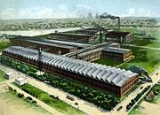
Cone Mills Corporation
Encyclopedia
Cone Mills Corporation was a world leader in textile manufacturing
of corduroy
, flannel
, denim
and other cotton fabrics for most of the 20th century. The company was based in Greensboro, North Carolina
and its mills were mostly in North
and South Carolina
. The company was known as the world's largest producer of denim
.
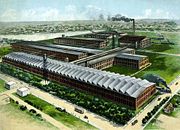 The Cone family history begins in 1845 when Herman Kahn (1828–1897), a Jewish-German
The Cone family history begins in 1845 when Herman Kahn (1828–1897), a Jewish-German
immigrant, and his sister’s family left their home in Bavaria, Germany for a new life in the United States. Herman changed the spelling of his last name from Kahn to "Cone" almost immediately upon arrival in the United States to become more American
.
Herman Cone and his brother-in-law Jacob Adler started a dry goods
business in the German-speaking Pennsylvania Dutch
town of Jonesboro, Tennessee. Cone & Adler sold the usual items like groceries, hats, boots, and shoes. An exception to this was that they also sold ready-to-wear clothing, unusual in the antebellum South where most clothing was made at home.
Herman met Helen Guggenheimer (1838–1898) in one of his business traveling trips to Lynchburg, Virginia
in the early part of the 1850s. She was also from Germany and was of the Jewish faith. In 1856, when Helen was eighteen, they got married. Their first child was Moses H. Cone
, born in 1857, founder of Proximity Manufacturing Company (original name for the Cone Mills enterprises
). Their next was Ceasar, born in 1859, the co-founder.
The family showed in the pre-Civil War
1860 census that their real estate holdings and personal property holdings were an impressive $29,365. By 1861 they closed their business because of the war and put their money instead into real estate. At the end of the war they sold some of their real estate to reopen their retail business under the name Adler, Cone, and Shipley.
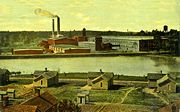 They engaged in the barter
They engaged in the barter
system to trade goods, since cash was then very scarce. They traded their goods for textiles and then resold these in the South
for cash. Many times they just took credit on personal property and land. They foreclosed on many of the debts owed them, acquiring hundreds of acres of real estate in the process.
In 1870 the family, who at this point was fairly wealthy, moved to Baltimore, Maryland and started a wholesale grocery business called Guggenheimer, Cone & Company. The family at this point had seven children, five boys and two girls, Claribel and Etta, who gained a reputation as the art-collecting Cone sisters. This business owned by several relative members was ultimately disbanded in 1873 and Herman went into business with his eldest sons, Moses and Ceasar. This new firm was called H. Cone & Sons. The two eldest, Moses and Ceasar, worked with their father in his grocery business while in their teens traveling the Southeast
as "drummers" (traveling salesmen). They took and bartered orders from southern merchants for their father's wares. By 1876 the business had expanded to include tobacco and leather goods.
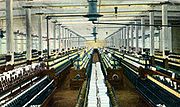 In 1887, Moses and Ceasar Cone invested $50,000 in the C. E. Graham Mill Manufacturing Company of Asheville, North Carolina
In 1887, Moses and Ceasar Cone invested $50,000 in the C. E. Graham Mill Manufacturing Company of Asheville, North Carolina
. They manufactured cotton plaid
s. In 1893 it became Asheville Cotton Mills. In 1888, the brothers invested in Salisbury Cotton Mills of Salisbury, North Carolina
. They also invested in Minneola Manufacturing Company of Gibsonville, North Carolina
. In 1891, Moses and Ceasar Cone established the Cone Export & Commission Company. The selling agent for southern textiles was called a "plaid trust" by its competitors. Chartered in New Jersey, the company's headquarters were located in New York city
and Moses served as its president. In 1893, the Cone brothers then built one of the first textile finishing
plants in the South, called Southern Finishing & Warehouse Company.
Moses Cone built his first denim manufacturing plant in Greensboro in 1895. It was called the Proximity Cotton Mills because of its location to the nearby cotton fields. Near the mills "Brother Moses" and "Brother Ceasar" built a facility to serve as the company's headquarters. Ceasar was its first president.
The Cone family, many of whom later were involved in Moses and Ceasar's enterprises, included Carrie (1861–1927), Monroe (1862–1891), Claribel (1864–1929), Albert (1866–1867), Solomon (1868–1939), Sydney M. (1869–1939), Etta (1870–1949), Julius W. (1872–1940), Bernard M. (1874–1956), Clarence N. (1876–1929), and Frederick W. (1878-1944).
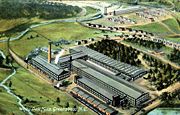 In 1899 Moses and Ceasar partnered with Emanuel and Herman Sternberger of South Carolina to build a flannel
In 1899 Moses and Ceasar partnered with Emanuel and Herman Sternberger of South Carolina to build a flannel
production plant called Revolution Mills. In 1905 under Proximity Manufacturing Company the Cone brothers built White Oak Cotton Mills in Greensboro. By 1908 it was the world's largest producer of denim. The heavy-duty blue denim manufactured by the mills controlled by Moses gave him the reputation of being "the Denim King." The company has produced the denim fabric for Levi Strauss & Company
since 1915. They are the exclusive supplier in recent years of the fabric for Levi's brand 501 jeans.
In 1912 the company opened Proximity Print Works. This plant was one of the earliest color cloth printing facilities in the Southern United States
. In 1927 the company acquired Cliffside Cotton Mills (manufacturer of terry cloth) and Haynes Plant (producer of chambray
). By 1929 they had acquired Holt-Granite Puritan Mills Company of Haw River, North Carolina
. They then acquired the corduroy
producing Tabardrey Manufacturing Company. By 1932 the Cone company had gained controlling stock of Eno Cotton Mills of Hillsborough, North Carolina
. They bought the Florence Mills of Forest City, North Carolina
in 1941 and also its subsidiary called American Spinning Company of Greenville, South Carolina
.
Then in 1948 another major merger occurred. Revolution Mills and Proximity Manufacturing Company was consolidated and named Cone Mills Corporation. In 1950 the company announced a merger with the twill and drill manufacturer Dwight Manufacturing Company of Alabama. The following year it purchased the company outright, being the same year the Corporation went public trading on the New York Stock Exchange
.
Cone Mills Corporation in 1952 purchased the Union Bleachery of Greenville, South Carolina. They then gained the first license for the sanforizing
process granted in the United States.
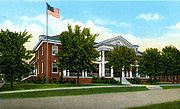 Cone Mills Corporation was involved with Cone Memorial YMCA (the White Oak, Proximity, and segregated branches), Camp Herman, night school, and employment of nurses. They built housing near their mills, both boarding houses and single family homes. Stores sold dairy products and meat was produced on company farms. The company built a school and donated land for churches for each village. The company also instituted a Welfare Office.
Cone Mills Corporation was involved with Cone Memorial YMCA (the White Oak, Proximity, and segregated branches), Camp Herman, night school, and employment of nurses. They built housing near their mills, both boarding houses and single family homes. Stores sold dairy products and meat was produced on company farms. The company built a school and donated land for churches for each village. The company also instituted a Welfare Office.
They were also involved with state and regional cotton and textile associations, the Mill Workers Mutual Benefit Association, and Summit Avenue Building Company. The company was also associated with the Cone Country Club and founded the Moses H. Cone Memorial Hospital
.
From 1958 to 1969 they were involved with the annual Miss North Carolina Pageant
. The company provided fabric for wardrobes that were given to each year's winner. They also provided fabric for the presentation gown that each winner wore to represent North Carolina in the annual Miss America Pageant.
The company went private again in 1983 with the threat of a takeover by Western Pacific Industries. At the time the company had twenty-one plants and 10,800 employees. The company then had a value of $385 million. In 2003, Cone Mills Corporation filed for Chapter 11 bankruptcy protection. By 2004, all of Cone's assets had been acquired by W. L. Ross and Company and were then combined with what remained of Burlington Industries
to form International Textile Group
.
Textile manufacturing
Textile manufacturing is a major industry. It is based in the conversion of three types of fibre into yarn, then fabric, then textiles. These are then fabricated into clothes or other artifacts. Cotton remains the most important natural fibre, so is treated in depth...
of corduroy
Corduroy
Corduroy is a textile composed of twisted fibers that, when woven, lie parallel to one another to form the cloth's distinct pattern, a "cord." Modern corduroy is most commonly composed of tufted cords, sometimes exhibiting a channel between the tufts...
, flannel
Flannel
Flannel is a soft woven fabric, of various fineness. Flannel was originally made from carded wool or worsted yarn, but is now often made from either wool, cotton, or synthetic fibre. Flannel may be brushed to create extra softness or remain unbrushed. The brushing process is a mechanical process...
, denim
Denim
Denim is a rugged cotton twill textile, in which the weft passes under two or more warp threads. This produces the familiar diagonal ribbing identifiable on the reverse of the fabric, which distinguishes denim from cotton duck. Denim has been in American usage since the late 18th century...
and other cotton fabrics for most of the 20th century. The company was based in Greensboro, North Carolina
Greensboro, North Carolina
Greensboro is a city in the U.S. state of North Carolina. It is the third-largest city by population in North Carolina and the largest city in Guilford County and the surrounding Piedmont Triad metropolitan region. According to the 2010 U.S...
and its mills were mostly in North
North Carolina
North Carolina is a state located in the southeastern United States. The state borders South Carolina and Georgia to the south, Tennessee to the west and Virginia to the north. North Carolina contains 100 counties. Its capital is Raleigh, and its largest city is Charlotte...
and South Carolina
South Carolina
South Carolina is a state in the Deep South of the United States that borders Georgia to the south, North Carolina to the north, and the Atlantic Ocean to the east. Originally part of the Province of Carolina, the Province of South Carolina was one of the 13 colonies that declared independence...
. The company was known as the world's largest producer of denim
Denim
Denim is a rugged cotton twill textile, in which the weft passes under two or more warp threads. This produces the familiar diagonal ribbing identifiable on the reverse of the fabric, which distinguishes denim from cotton duck. Denim has been in American usage since the late 18th century...
.
Early history

History of the Jews in Germany
The presence of Jews in Germany has been established since the early 4th century. The community prospered under Charlemagne, but suffered during the Crusades...
immigrant, and his sister’s family left their home in Bavaria, Germany for a new life in the United States. Herman changed the spelling of his last name from Kahn to "Cone" almost immediately upon arrival in the United States to become more American
United States
The United States of America is a federal constitutional republic comprising fifty states and a federal district...
.
Herman Cone and his brother-in-law Jacob Adler started a dry goods
Dry goods
Dry goods are products such as textiles, ready-to-wear clothing, and sundries. In U.S. retailing, a dry goods store carries consumer goods that are distinct from those carried by hardware stores and grocery stores, though "dry goods" as a term for textiles has been dated back to 1742 in England or...
business in the German-speaking Pennsylvania Dutch
Pennsylvania Dutch
Pennsylvania Dutch refers to immigrants and their descendants from southwestern Germany and Switzerland who settled in Pennsylvania in the 17th and 18th centuries...
town of Jonesboro, Tennessee. Cone & Adler sold the usual items like groceries, hats, boots, and shoes. An exception to this was that they also sold ready-to-wear clothing, unusual in the antebellum South where most clothing was made at home.
Herman met Helen Guggenheimer (1838–1898) in one of his business traveling trips to Lynchburg, Virginia
Lynchburg, Virginia
Lynchburg is an independent city in the Commonwealth of Virginia. The population was 75,568 as of 2010. Located in the foothills of the Blue Ridge Mountains along the banks of the James River, Lynchburg is known as the "City of Seven Hills" or "The Hill City." Lynchburg was the only major city in...
in the early part of the 1850s. She was also from Germany and was of the Jewish faith. In 1856, when Helen was eighteen, they got married. Their first child was Moses H. Cone
Moses H. Cone
Moses Herman Cone was an American textile entrepreneur, conservationist, and philanthropist of the Gilded Age who was active in the southern United States...
, born in 1857, founder of Proximity Manufacturing Company (original name for the Cone Mills enterprises
Business
A business is an organization engaged in the trade of goods, services, or both to consumers. Businesses are predominant in capitalist economies, where most of them are privately owned and administered to earn profit to increase the wealth of their owners. Businesses may also be not-for-profit...
). Their next was Ceasar, born in 1859, the co-founder.
The family showed in the pre-Civil War
American Civil War
The American Civil War was a civil war fought in the United States of America. In response to the election of Abraham Lincoln as President of the United States, 11 southern slave states declared their secession from the United States and formed the Confederate States of America ; the other 25...
1860 census that their real estate holdings and personal property holdings were an impressive $29,365. By 1861 they closed their business because of the war and put their money instead into real estate. At the end of the war they sold some of their real estate to reopen their retail business under the name Adler, Cone, and Shipley.

Barter
Barter is a method of exchange by which goods or services are directly exchanged for other goods or services without using a medium of exchange, such as money. It is usually bilateral, but may be multilateral, and usually exists parallel to monetary systems in most developed countries, though to a...
system to trade goods, since cash was then very scarce. They traded their goods for textiles and then resold these in the South
Southern United States
The Southern United States—commonly referred to as the American South, Dixie, or simply the South—constitutes a large distinctive area in the southeastern and south-central United States...
for cash. Many times they just took credit on personal property and land. They foreclosed on many of the debts owed them, acquiring hundreds of acres of real estate in the process.
In 1870 the family, who at this point was fairly wealthy, moved to Baltimore, Maryland and started a wholesale grocery business called Guggenheimer, Cone & Company. The family at this point had seven children, five boys and two girls, Claribel and Etta, who gained a reputation as the art-collecting Cone sisters. This business owned by several relative members was ultimately disbanded in 1873 and Herman went into business with his eldest sons, Moses and Ceasar. This new firm was called H. Cone & Sons. The two eldest, Moses and Ceasar, worked with their father in his grocery business while in their teens traveling the Southeast
Southern United States
The Southern United States—commonly referred to as the American South, Dixie, or simply the South—constitutes a large distinctive area in the southeastern and south-central United States...
as "drummers" (traveling salesmen). They took and bartered orders from southern merchants for their father's wares. By 1876 the business had expanded to include tobacco and leather goods.

Asheville, North Carolina
Asheville is a city in and the county seat of Buncombe County, North Carolina, United States. It is the largest city in Western North Carolina, and the 11th largest city in North Carolina. The City is home to the United States National Climatic Data Center , which is the world's largest active...
. They manufactured cotton plaid
Plaid
Plaid may refer to:Material* A plaid or full plaid is a pleated cloth worn with the modern kilt, made from the same tartan and worn cast over the shoulder and fastened at the front* The belted plaid or "great kilt", earlier form of the kilt...
s. In 1893 it became Asheville Cotton Mills. In 1888, the brothers invested in Salisbury Cotton Mills of Salisbury, North Carolina
Salisbury, North Carolina
Salisbury is a city in Rowan County in North Carolina, a state of the United States of America. The population was 33,663 in the 2010 Census . It is the county seat of Rowan County...
. They also invested in Minneola Manufacturing Company of Gibsonville, North Carolina
Gibsonville, North Carolina
Gibsonville is a town in Alamance and Guilford counties in the U.S. state of North Carolina. It is part of the Greensboro-High Point, North Carolina Metropolitan Statistical Area...
. In 1891, Moses and Ceasar Cone established the Cone Export & Commission Company. The selling agent for southern textiles was called a "plaid trust" by its competitors. Chartered in New Jersey, the company's headquarters were located in New York city
New York City
New York is the most populous city in the United States and the center of the New York Metropolitan Area, one of the most populous metropolitan areas in the world. New York exerts a significant impact upon global commerce, finance, media, art, fashion, research, technology, education, and...
and Moses served as its president. In 1893, the Cone brothers then built one of the first textile finishing
Finishing (textiles)
In textile manufacturing, finishing refers to any process performed on yarn or fabric after weaving or knitting to improve the look, performance, or "hand" of the finished textile or clothing...
plants in the South, called Southern Finishing & Warehouse Company.
Moses Cone built his first denim manufacturing plant in Greensboro in 1895. It was called the Proximity Cotton Mills because of its location to the nearby cotton fields. Near the mills "Brother Moses" and "Brother Ceasar" built a facility to serve as the company's headquarters. Ceasar was its first president.
The Cone family, many of whom later were involved in Moses and Ceasar's enterprises, included Carrie (1861–1927), Monroe (1862–1891), Claribel (1864–1929), Albert (1866–1867), Solomon (1868–1939), Sydney M. (1869–1939), Etta (1870–1949), Julius W. (1872–1940), Bernard M. (1874–1956), Clarence N. (1876–1929), and Frederick W. (1878-1944).
Turn of the century

Flannel
Flannel is a soft woven fabric, of various fineness. Flannel was originally made from carded wool or worsted yarn, but is now often made from either wool, cotton, or synthetic fibre. Flannel may be brushed to create extra softness or remain unbrushed. The brushing process is a mechanical process...
production plant called Revolution Mills. In 1905 under Proximity Manufacturing Company the Cone brothers built White Oak Cotton Mills in Greensboro. By 1908 it was the world's largest producer of denim. The heavy-duty blue denim manufactured by the mills controlled by Moses gave him the reputation of being "the Denim King." The company has produced the denim fabric for Levi Strauss & Company
Levi Strauss & Co.
Levi Strauss & Co. is a privately held American clothing company known worldwide for its Levi's brand of denim jeans. It was founded in 1853 when Levi Strauss came from Buttenheim, Franconia, to San Francisco, California to open a west coast branch of his brothers' New York dry goods business...
since 1915. They are the exclusive supplier in recent years of the fabric for Levi's brand 501 jeans.
In 1912 the company opened Proximity Print Works. This plant was one of the earliest color cloth printing facilities in the Southern United States
Southern United States
The Southern United States—commonly referred to as the American South, Dixie, or simply the South—constitutes a large distinctive area in the southeastern and south-central United States...
. In 1927 the company acquired Cliffside Cotton Mills (manufacturer of terry cloth) and Haynes Plant (producer of chambray
Chambray
Chambray is a commune in the Eure department in northern France, located 13 km northeast of Évreux on the north bank of the Eure River.-Population:-References:*...
). By 1929 they had acquired Holt-Granite Puritan Mills Company of Haw River, North Carolina
Haw River, North Carolina
Haw River is a town in Alamance County, North Carolina, United States. It is part of the Burlington, North Carolina Metropolitan Statistical Area. The current population estimate is 2,012.-Geography:Haw River is located at ....
. They then acquired the corduroy
Corduroy
Corduroy is a textile composed of twisted fibers that, when woven, lie parallel to one another to form the cloth's distinct pattern, a "cord." Modern corduroy is most commonly composed of tufted cords, sometimes exhibiting a channel between the tufts...
producing Tabardrey Manufacturing Company. By 1932 the Cone company had gained controlling stock of Eno Cotton Mills of Hillsborough, North Carolina
Hillsborough, North Carolina
Hillsborough is a town in Orange County, North Carolina, United States. The population was 5,653 at the 2008 census. It is the county seat of Orange County....
. They bought the Florence Mills of Forest City, North Carolina
Forest City, North Carolina
Forest City, formerly known as "Burnt Chimney," is a town in Rutherford County, North Carolina, United States. The population was 7,549 as of the 2000 census.-Geography:Forest City is located at ....
in 1941 and also its subsidiary called American Spinning Company of Greenville, South Carolina
Greenville, South Carolina
-Law and government:The city of Greenville adopted the Council-Manager form of municipal government in 1976.-History:The area was part of the Cherokee Nation's protected grounds after the Treaty of 1763, which ended the French and Indian War. No White man was allowed to enter, though some families...
.
Company changes name
In 1945 the company merged all its separate mill properties into the Proximity Manufacturing Company. The manufacturing companies, mills, and various subsidiaries owned by the Cones underwent a major reorganization in which the separate business operations of Proximity Manufacturing Company (including Proximity Cotton Mills, Proximity Print Works, White Oak, and Granite), the Cliffside Mills (including the Cliffside and Haynes plants), the Florence Mills (including American Spinning Company), Minneola Manufacturing Company, Salisbury Cotton Mills, Tabardrey Manufacturing Company, and Cone Export & Commission Company, were all reorganized.Then in 1948 another major merger occurred. Revolution Mills and Proximity Manufacturing Company was consolidated and named Cone Mills Corporation. In 1950 the company announced a merger with the twill and drill manufacturer Dwight Manufacturing Company of Alabama. The following year it purchased the company outright, being the same year the Corporation went public trading on the New York Stock Exchange
New York Stock Exchange
The New York Stock Exchange is a stock exchange located at 11 Wall Street in Lower Manhattan, New York City, USA. It is by far the world's largest stock exchange by market capitalization of its listed companies at 13.39 trillion as of Dec 2010...
.
Cone Mills Corporation in 1952 purchased the Union Bleachery of Greenville, South Carolina. They then gained the first license for the sanforizing
Sanforization
Sanforization is a process of treatment used for cotton fabrics mainly and most textiles made from natural or chemical fibres, patented by Sanford Lockwood Cluett in 1930...
process granted in the United States.
Involvement with other organizations

They were also involved with state and regional cotton and textile associations, the Mill Workers Mutual Benefit Association, and Summit Avenue Building Company. The company was also associated with the Cone Country Club and founded the Moses H. Cone Memorial Hospital
Moses H. Cone Memorial Hospital
The Moses H. Cone Memorial Hospital, also known as Moses Cone Hospital, is a 535 bed tertiary care facility located in Greensboro, North Carolina. The hospital opened in 1953 on North Elm Street as a 310 bed community hospital...
.
From 1958 to 1969 they were involved with the annual Miss North Carolina Pageant
Miss North Carolina
The Miss North Carolina competition is the pageant that selects the representative for the state of North Carolina in the Miss America pageant. The competition has been held in Raleigh every year since 1978. Prior to that, it was held in various locales including Charlotte, Greensboro, Burlington,...
. The company provided fabric for wardrobes that were given to each year's winner. They also provided fabric for the presentation gown that each winner wore to represent North Carolina in the annual Miss America Pageant.
Company comes to an end
The textile companies and plants owned and operated in full or in part by the Cone family were Revolution Cotton Mills, Asheville Cotton Mills, Minneola Manufacturing Company, Salisbury Cotton Mills, Cliffside Mills, Eno Cotton Mills, Granite Finishing Works, Tabardrey Manufacturing Company, Florence Mills, John Wolf Textiles, Olympic Products, and American Spinning Company.The company went private again in 1983 with the threat of a takeover by Western Pacific Industries. At the time the company had twenty-one plants and 10,800 employees. The company then had a value of $385 million. In 2003, Cone Mills Corporation filed for Chapter 11 bankruptcy protection. By 2004, all of Cone's assets had been acquired by W. L. Ross and Company and were then combined with what remained of Burlington Industries
Burlington Industries
Burlington Industries is a diversified U. S. fabric maker based in Greensboro, North Carolina. Founded in 1923, the company has operations in the United States, Mexico, and India and a global manufacturing and product development network based in Hong Kong. The company entered Chapter 11...
to form International Textile Group
International Textile Group
International Textile Group is a diversified U.S. fabric maker based in Greensboro, North Carolina. It acquired the assets of the former Burlington Industries out of bankruptcy in late 2003, and the assets of the former Cone Mills Corporation in 2004...
.
The Cone Mill Villages
Mill villages were company-owned towns, built from scratch by textile mills to house their factory workers and their families. In the early 1900s, Cone Mills Inc. built five self-sufficient villages to serve its Greensboro factories. These villages included churches, schools, ballfields, community centers, and company stores in addition to houses that were leased to mill workers. At their peak, the Cone mill villages covered 450 acres (1.8 km²) and housed 2,675 workers in about 1,500 houses. A separate mill village, East White Oak, housed African-American workers. Thousands of workers and their families made their lives in these “towns within a town” until the company began selling the houses (sometimes to workers) in the late 1940s.Primary sources
- Inventory of the Cone Mills Corporation Records, 1858-1997, in the Southern Historical CollectionSouthern Historical CollectionThe Southern Historical Collection is a repository of distinct archival collections at the University of North Carolina at Chapel Hill which document the culture and history of the American South...
, UNC-Chapel HillUniversity of North Carolina at Chapel HillThe University of North Carolina at Chapel Hill is a public research university located in Chapel Hill, North Carolina, United States...
Secondary sources
- Gabriel, Mary, The Art of Acquiring: A Portrait of Etta and Claribel Cone, Bancroft Press 2002, ISBN 1890862061
- Renouf, Norman, Romantic Weekends the Carolinas & the Georgia Coast, Hunter Publishing 1999, ISBN 1556508549
- American Council of Learned Societies, Dictionary of American Biography, Scribner publisher 1958, original at University of MichiganUniversity of MichiganThe University of Michigan is a public research university located in Ann Arbor, Michigan in the United States. It is the state's oldest university and the flagship campus of the University of Michigan...
library.
- Noblitt, Philip T., A Mansion in the Mountains: The Story of Moses and Bertha Cone and their Blowing Rock Manor, Parkway Publishers 1996, ISBN 1887905022

